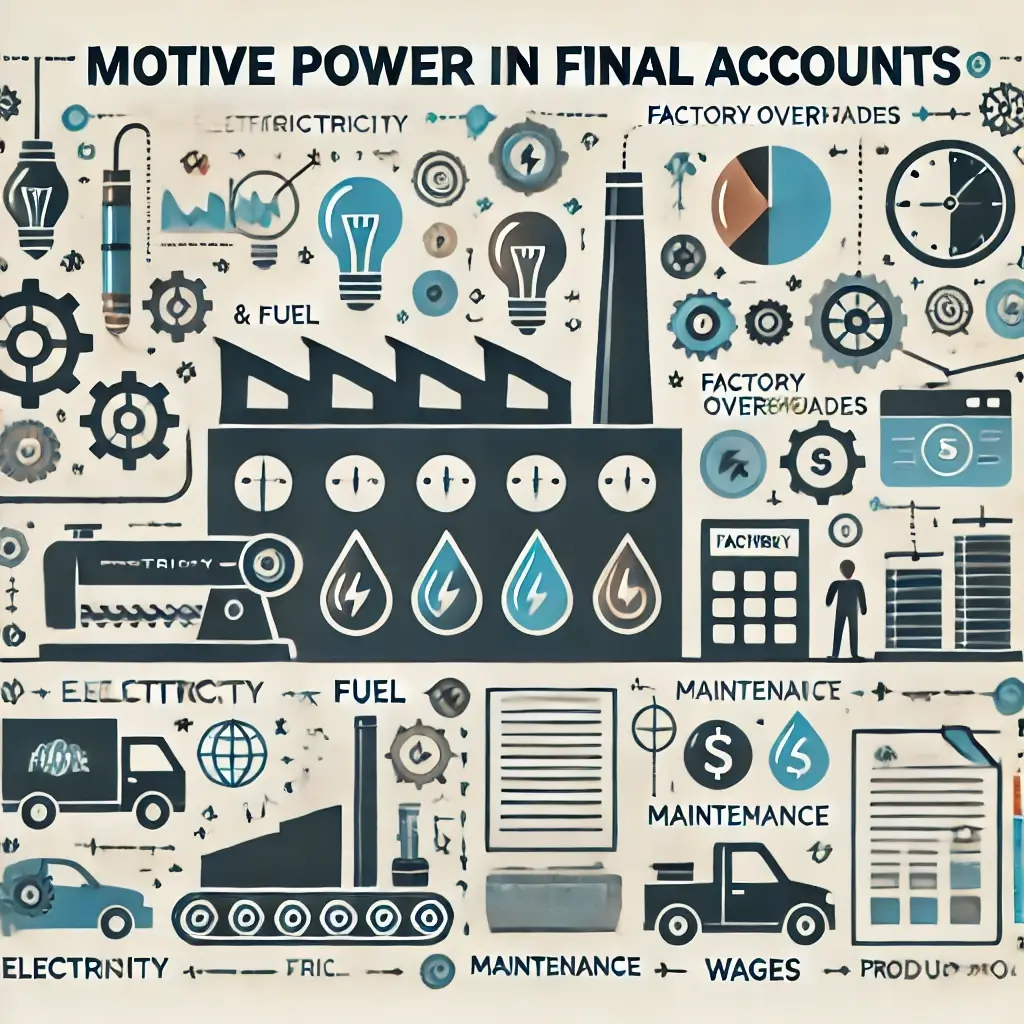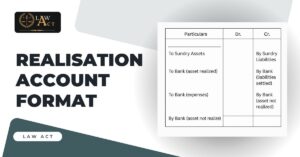Motive power in final accounts refers to the expenses related to the energy or power needed to run the machinery and equipment. Besides, the manufacturing or production-related industries are usually where these costs are found.
Motive power expenses can include costs such as:
- Electricity Costs: For running electric motors and machines.
- Fuel Costs: The cost of running engines, generators, or other fuel-powered equipment.
- Maintenance: The costs for maintaining the machinery to ensure efficient operation.
- Wages of Operators: This expense belongs to the wages that are paid to the worker.
At the end of the financial year, we record motive expenses in the final account in the Profit and Loss Account (Income Statement). It is recorded under factory overhead or manufacturing expenses. After that, these expenses are deducted from the revenue to calculate the net profit or loss of the business. Now let us move ahead to know the accounting treatment of motive power.

Accounting Treatment Motive Power in Final Accounts
Inclusion in Factory Overheads
- Motive power expenses are covered under factory or manufacturing overheads.
- These indirect expenses related to the production process are not attributed to any specific product.
- In the Factory overhead section, we include all indirect costs related to manufacturing, such as utilities, maintenance, and machinery depreciation.
Presentation in Profit and Loss Account (Income Statement)
Factory overheads are a part of the Cost of Goods Sold (COGS), including motive power expenses. The gross profit, which represents all indirect manufacturing costs, including motive power charges, is added to the Profit and Loss Account by deducting COGS from revenue.
Calculation Example for Motive Power in Final Accounts
Recording of Motive Power Expenses:
| Description | Amount (₹) |
|---|---|
| Electricity cost | 500 |
| Fuel cost | 300 |
| Maintenance cost | 200 |
| Wages | 400 |
| Total Motive Power Expenses | 1,400 |
In Factory Overheads:
| Description | Amount (₹) |
|---|---|
| Total Motive Power Expenses | 1,400 |
| Other Factory Overheads | 2,600 |
| Total Factory Overheads | 4,000 |
Suppose other factory overheads are ₹2,600.
Total Factory Overheads = ₹1,400 (Motive Power) + ₹2,600 = ₹4,000
Allocation to WIP and COGS
- Now, the total factory overheads of ₹4,000 that you can assign to the Work in Progress account.
- After completing all the products, now you will move these costs to the Goods Sold account and it will impact the final profit estimation.
When you include motive power expenses in the factory overheads then you can accurately capture all indirect costs of manufacturing. So that you manage your cost and financial reporting.
Also Check:
- Common Final Accounts Problems and How to Solve Them
- Establishment Expenses in Final Accounts
- Applicability of Accounting Standards
- Trade Expenses in Final Accounts
Significance of the Motive Power in Final Accounts
Impact on Cost of Production
By doing accurate tracking of your company’s motive power expenses you can determine the true cost of manufacturing products.
Role in Pricing Decisions
If you understand these expenses then you will be able to decide the right price for your product covering all costs. Therefore, it will lead to profitable pricing strategies.
Influence on Overall Profitability
The proper management of motive power in final accounts can affect your business’s net profit and help you in better financial planning and analysis.
Cost Control and Efficiency
Well, if you monitor your motive power expenses then you can find the areas where you can reduce the cost and improve the efficiency in the production process.
Compliance and Reporting
In business, it is very important to record expenses with the highest accuracy. So that in the future you can enhance the reliability of financial reports.
Conclusion
Companies need to understand Motive Power in Final Accounts expenses if they are producing goods. These expenses including gasoline and electricity have a direct impact on the cost of production as well as the business’s profit margin. Therefore, if you manage your motive power in financial accounts, you will ensure better financial planning and compliance with accounting standards. This leads to improved efficiency and more reliable financial reporting.
Also Read:
- Trade Expenses in Trial BalanceUnderstanding financial terms is important for every business owner, student, or anyone interested in accounting. One such term is “Trade Expenses”, especially when it appears in the trial balance. This blog will explain what trade expenses are and what their… Read more: Trade Expenses in Trial Balance
- Legal Charges in Final AccountsWhen preparing final accounts for a business, one important topic that often confuses people is legal charges. These charges are not just legal fees or penalties. They have a specific meaning in accounting and finance. In this blog, we will… Read more: Legal Charges in Final Accounts
- Realisation Account FormatManagement of finances is always a must in any business, regardless of how large or small the business might be. Among the key tools in accounting is the Realisation Account. It is especially used in the process of winding up… Read more: Realisation Account Format
- Motive Power in Final AccountsMotive power in final accounts refers to the expenses related to the energy or power needed to run the machinery and equipment. Besides, the manufacturing or production-related industries are usually where these costs are found. Motive power expenses can include… Read more: Motive Power in Final Accounts
- Common Final Accounts Problems and How to Solve ThemAre you facing any final accounts problems? Then this blog is for you, here we will explain how you can solve those problems. By going through this article you can solve issues like incorrect trial balance, missing documentation, and many… Read more: Common Final Accounts Problems and How to Solve Them
Frequently asked questions
What is the motive power in final accounts?
Motive power in final accounts refers to the costs of running machinery and equipment in a factory, such as electricity, fuel, and maintenance. These costs are part of factory overheads and are included in the cost of making products, affecting the overall profit calculation.
How does motive power affect profits?
Motive power costs, like electricity and fuel for machines, are part of making products. If these costs are high, it reduces the money left as profit. Managing these costs well means spending less on production, which helps keep more profit for the business.
Why is motive power crucial in accounting?
Motive power in final accounts is important in accounting because it represents the costs of running machinery, like electricity and fuel. Tracking these expenses accurately helps firms understand their production costs, set the right prices for their products, and manage their finances better, leading to improved returns and efficiency.
What role does motive power play in balance sheets?
Motive power expenses don’t directly appear on the balance sheet but affect it indirectly. They are part of the cost of goods sold, reducing net income on the income statement. Therefore, lower net income results in lower retained earnings, which is a component of the equity section on the balance sheet.
How do you calculate motive power?
To calculate motive power expenses, add up all the costs related to running machinery. This includes electricity, fuel, maintenance, and wages for operators. For example, if electricity costs $500, fuel $300, maintenance $200, and wages $400, the total motive power expense would be $1,400.
Why analyze motive power in financial statements?
Exploring motive power in financial statements helps businesses understand the costs of running machinery. This ensures correct product pricing, better cost control, and improved efficiency. Moreover, it also aids in financial planning, observation with standards, and making informed business decisions, finally leading to increased profitability.
What are the types of motive power?
Types of motive power in final accounts include electricity, used to run electric motors; fuel, like diesel or gasoline, for engines; steam, produced by boilers for steam engines; and renewable sources, such as solar or wind power, which drive various machinery. These power sources are essential for operating equipment in manufacturing and production.
How does motive power impact business decisions?
Motive power impacts business decisions by impacting production costs and pricing plans. Managing these costs effectively provides products that are priced competitively while holding profitability. Moreover, it also helps in budgeting, identifying cost-saving opportunities, and making informed decisions to enhance overall business performance.
How can motive power be improved?
Motive power can be improved by optimizing energy use, maintaining machinery regularly, training operators for efficiency, and exploring energy-saving technologies. Monitoring and reducing wastage also help. Therefore, these efforts not only cut costs but also enhance productivity and sustainability in manufacturing operations.
What are examples of high motive power?
Examples of high motive power include heavy machinery used in industries like manufacturing and mining, and large-scale equipment such as cranes, bulldozers, and industrial pumps. In addition, these machines require significant energy, typically sourced from electricity or fuel, to operate efficiently and powerfully in their respective tasks.








